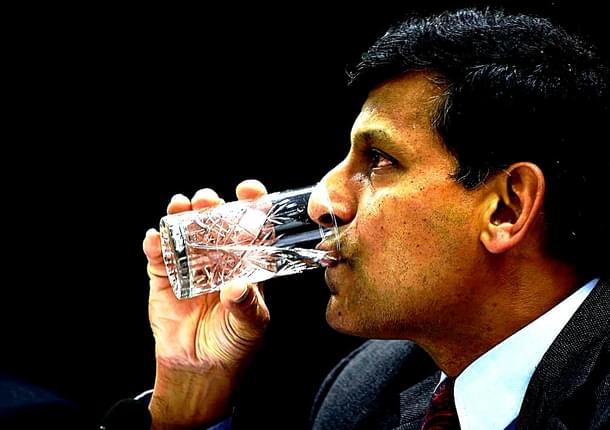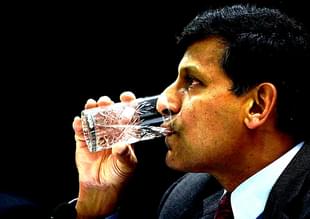Economy
Raghuram Rajan Has The Last Laugh
V Anantha Nageswaran
Jun 08, 2017, 04:35 PM | Updated 04:35 PM IST
Save & read from anywhere!
Bookmark stories for easy access on any device or the Swarajya app.


Maybe it’s the way the government made Rajan leave office last year—it was bad karma, and it’s coming back to hit them.
On Tuesday, in my regular weekly column, I had written that the Gross Domestic Product (GDP) data for 2016-17 released on 31 May was a wake-up call for the Indian government and for the Reserve Bank of India (RBI). The decline in the ratio of Gross Fixed Capital Formation to GDP to around 25.5 per cent in the fourth quarter of 2016-17 in nominal terms was a shocker to me. This is not the stuff of a big-league economy.
What has gone wrong? There are several culprits and each one must do what they can do instead of arguing that someone else must act first and only then will their actions be meaningful. We do not know in economics with such precision. We act and hope for the best. That is the best that can be said about economic policymaking.
(1) The government: It has consistently underestimated the growth challenge in the Indian economy. It has swallowed its own propaganda of the ‘world’s fastest growing large economy’. It failed to understand and grasp the structural impediments that the economy was trapped under. It agreed to a pro-cyclical massive fiscal tightening in 2014-15 when it took office. The real fiscal deficit it inherited was close to 6.0 per cent and it agreed for a target of 4.1 per cent in 2014-15. That was in the backdrop of a failed monsoon. The collapse in the oil economy prevented its folly from becoming a big blunder.
Subsequently, it had also dilly-dallied on dealing with the non-performing loan (NPA) problem in the banking sector. Majority of the loans are held by banks in which it is the dominant shareholder. The top managements in these banks are its nominees. Its nominees sit on the board of directors.
Nothing prevented the government from calling an all-party meeting or two and then also knocking heads together with vigilance agencies to allow price discovery of these loans and their resolution from moving forward. Yes, all this takes time. But, I leave it to you to decide for yourself if 36 months was enough time or not.
Third, it has pursued a policy of targeting tax dodgers and other wrongdoers in the business community. Nothing wrong here. I am not even going into the question of whether the government had been selective or unbiased in these pursuits. It has done well to do this for it is never the case of this blogger that India’s private sector is an epitome of business ethics and virtues. Far from it. India’s economy or capitalism always was in peril and is in peril from India’s capitalists with very few honourable exceptions. So, the pursuit was fine.
But, the government should have realised that it would have an impact on sentiment and on investment by businesses. It must have had a Plan B already. Large-scale privatisations (some trophy but chronic loss-making entities like AIR INDIA) either through strategic sale or though Further Placement Offering in capital markets (FPO) should have been contemplated to shore up sentiment and to create a mood of policy dynamism and progressive thinking, etc., especially in the context of what it did on 8 November 2016. It has done nothing of that sort.
The short-term contractionary impact of ‘note-ban’ decision exercise was not taken into consideration in the preparation of offsetting measures in the budget for 2017-18. The budget was a pedestrian document and it lacked imagination. Post-note-ban, the country needed an offsetting positive excitement. The budget ensured that it did not happen.
So, the government does have a large share of the blame for the current growth malaise in India.
(2) The Central Statistical Organisation: When the history of India’s economic cycles is written for this period, much of the blame must be and will be assigned to this organisation for creating a false perception of ‘all is well’ about the Indian economy. Its ‘no resemblance to reality’ growth prints of 7 per cent or higher had robbed all of the sense of urgency, most of all in the Indian government. Further, it has done nothing to remove the suspicions that still linger over its methodology.
All that we receive, every now and then, from commentators is a reassurance that there is no mala fide in Indian economic growth numbers and that the CSO leadership scores high on integrity. That is not even an issue for discussion.
In fact, it is well known that it makes no sense to attribute malice to something that could be explained by incompetence.
That the Indian economy grew 6.4 per cent in 2013-14 is no laughing matter. But, it is laughable. It is very hard to reconcile with lots of statistics – from mobile phone sales to airline traffic to rail freight traffic to cement production to current account deficit shrinkage, etc. The growth rate was close to 4.0 per cent then.
Similarly, with credit growth to industries contracting, with private capital formation rates shrinking, with production in infrastructure industries sluggish at best and contracting at worst, with demand for electricity not rising, it is hard to see that the economy is growing at 7.5 per cent.
The CSO might have more data now on the corporate sector, etc., But, how the data are processed also matters. For outsiders, it remains a black box.
The CSO has played a very big role in inducing a perception of ‘all is normal and healthy in the economy’ in the government. Indeed, the biggest contribution that anyone can make to any country is to induce a sense of crisis in policymakers. That is what leads to policy reforms and action. Where possible and realistic, patriotic citizens must ensure that the policymakers that have their ears are gripped by a sense of crisis.
The banking crisis, the falling investment rates and the credit off-take were perfect crisis ingredients in India. But, the CSO did a lot to remove the crisis-effect of these on the government. That is a very big disservice it has done to India. I hope historians would take note of it and record it with adequate prominence.
(3) The Reserve Bank of India (RBI): The Indian central bank gets a free pass from the chattering classes, for the most part, especially from those based in Mumbai. It gets the benefit of doubt from them whereas the government in Delhi does not. Delhi is home to politicians who are not like us. Mumbai is home to the RBI which is led by people like us – elites, educated and thoughtful and therefore, it should be treated with respect and given the benefit of doubt, than not.
RBI adopted the inflation targeting regime when the rest of the world was having second thoughts on it. It is not a disaster, per se, even though much thought and discussion should have preceded it. That did not happen.
Even I was guilty of not being critical of its adoption because all of us were stung by the experience of five years of continuous annual double-digit inflation under the previous government from 2009 to 2014.
Further, its fiscal policy also undermined the independence of the central bank. Therefore, it is doubly unfortunate that the fiscal dominance of monetary policy and sustained annual double digit inflation for five years raised sympathies for an inflation targeting regime in India too.
But, in a social science subject like economics and policy framework based on a social science like economics, rules are guideposts and not millstones. It is what policymakers make of them. Creative interpretations have been made even in inflation targeting regimes. They can change the weights; they can creatively assume different lags (after all, they are long or short, variable or fixed as we like them).
For a creative reinterpretation of its mandate, ECB is enough example despite a Treaty-defined mandate only for inflation targeting. Not that I endorse what they do.
Yes, a framework does bind and can be an inconvenient one. Also, if someone stretched it once in one direction, on another occasion, another central banker can stretch it in another direction. But, that is an ever-present risk with all regimes.
The risk comes from the framework and from those who interpret and implement them.
A NPA situation bordering on 10 per cent of GDP and a capital formation rate of 25 per cent of GDP are outside the normal deviations that a creative interpretation of the inflation targeting regime was warranted, in my view, in the RBI policy meeting that concluded yesterday.
Hence, the central bank is guilty of being bookish.
Why should Raghuram Rajan have the last laugh? The title of the blog post is a reaction to the stories here and here. This government did an utterly foolish thing and made a spectacle of itself by the manner in which it had him leave office last year. There were far better ways of doing so. That was very bad karma and it is coming home to roost now.
Its current predicament and frustration with the current leadership of RBI are therefore well earned and well deserved.
This article was originally published on The Gold Standard, and has been republished here with permission.
V. Anantha Nageswaran has jointly authored, ‘Can India grow?’ and ‘The Rise of Finance:Causes, Consequences and Cures’





